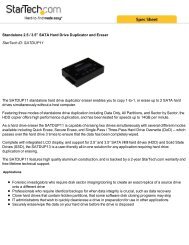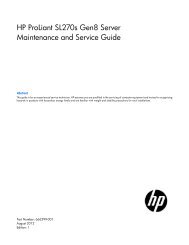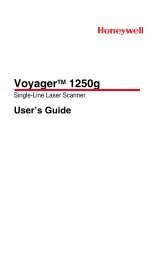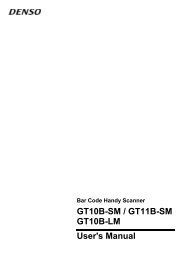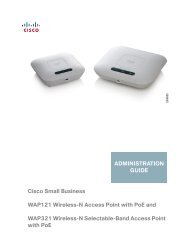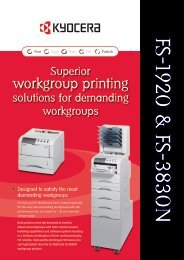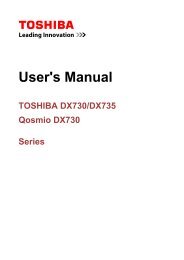User Manual - Etilize
User Manual - Etilize
User Manual - Etilize
Create successful ePaper yourself
Turn your PDF publications into a flip-book with our unique Google optimized e-Paper software.
Installing a memory module<br />
The following notes describe the types of dual inline memory modules (DIMMs) that<br />
the server supports and other information that you must consider when you install<br />
DIMMs (see “System-board optional-device connectors” on page 25 for the location<br />
of the DIMM connectors):<br />
v The server supports only industry-standard double-data-rate 3 (DDR3), 1066 or<br />
1333 MHz, PC3-8500 or PC3-10600 (single-rank, dual-rank, or quad-rank),<br />
registered or unbuffered, synchronous dynamic random-access memory<br />
(SDRAM) dual inline memory modules (DIMMs) with error correcting code (ECC).<br />
See http://www.ibm.com/servers/eserver/serverproven/compat/us/ for a list of<br />
supported memory modules for the server.<br />
v The maximum amount of memory that the server supports is dependent on the<br />
type of memory that you install in the server. See “Unbuffered DIMMs (UDIMMs)”<br />
on page 36 and “Registered DIMMs (RDIMMs)” on page 37 for more information.<br />
v The amount of usable memory is reduced, depending on the system<br />
configuration. A certain amount of memory must be reserved for system<br />
resources. To view the total amount of installed memory and the amount of<br />
configured memory, run the Setup utility. For additional information, see “Using<br />
the Setup utility” on page 68.<br />
v The maximum operating speed of the server is determined by the slowest DIMM<br />
in the server.<br />
v If you install a pair of DIMMs in DIMM connectors 2 and 5, the size and speed of<br />
the DIMMs that you install in DIMM connectors 2 and 5 must match each other.<br />
However, they do not have to be the same size and speed as the DIMMs that<br />
are installed in DIMM connectors 1 and 4.<br />
v You can use compatible DIMMs from various manufacturers in the same pair.<br />
v When you install or remove DIMMs, the server configuration information<br />
changes. When you restart the server, the system displays a message that<br />
indicates that the memory configuration has changed.<br />
v The specifications of a DDR3 DIMM are on a label on the DIMM, in the following<br />
format.<br />
ggg eRxff-PC3-wwwwwm-aa-bb-cc<br />
where:<br />
ggg is the total capacity of the DIMM (for example, 1GB, 2GB, or 4GB)<br />
e is the number of ranks<br />
1 = single-rank<br />
2 = dual-rank<br />
4 = quad-rank<br />
ff is the device organization (bit width)<br />
4 = x4 organization (4 DQ lines per SDRAM)<br />
8 = x8 organization<br />
16 = x16 organization<br />
wwwww is the DIMM bandwidth, in MBps<br />
8500 = 8.53 GBps (PC3-1066 SDRAMs, 8-byte primary data bus)<br />
10600 = 10.66 GBps (PC3-1333 SDRAMs, 8-byte primary data bus)<br />
m is the DIMM type<br />
E = Unbuffered DIMM (UDIMM) with ECC (x72-bit module data bus)<br />
R = Registered DIMM (RDIMM)<br />
Chapter 2. Installing optional devices 35




